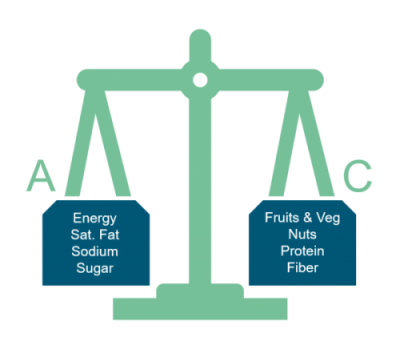New marketing and advertising restrictions were introduced by the UK Government in 2021. These affect how the food and beverage industry can promote and locate certain products in store and advertise on TV and online, with children’s health being a key driver.

The main legislative changes include:
- Restrictions on volume-price promotions and locations for product selling (pre-packed products only)1
- TV and online advertising bans2
- Mandatory calorie labelling for all products on menus for out of home businesses (OOH)3
These regulations target products that are deemed “less healthy” or “HFSS” (High in Fat, Sugar, and/or Salt) as defined by the 2004/2005 UK nutrient profile model (NPM)4.
This article serves as a guide to help you understand the regulations and specific ways to improve nutrition of food to avoid the restrictions imposed by legislation:
- What regulations are coming and when?
- What is HFSS?
- How do I move my product from HFSS to Non-HFSS?
- What do I need to do and when?
What regulations are coming and when?
In 2021 the UK Government introduced restrictions on the marketing of foods and beverages classified as high in fat, sugar, and/or salt (HFSS). This includes two key pieces of legislation: Price promotion and location restrictions, and TV and online advertising restrictions.
Price promotion and location restrictions
 From October 2022 HFSS products are no longer permitted to be sold at store entrances, aisle ends, or checkout areas. For online shopping this equates to the entry page of websites, pages where customers view their shopping basket or proceed to payment, and the side banners of pages. In October 2023, promotions that encourage an increase in the volume of product purchased will no longer be permitted for HFSS foods and beverages. This includes multi-buy promotions e.g. ‘buy one get one free’, ‘3 for 2’ etc., extra free promotions such as ‘30% extra free’, and free refills of sugar sweetened drinks in the OOH sector. In addition,
From October 2022 HFSS products are no longer permitted to be sold at store entrances, aisle ends, or checkout areas. For online shopping this equates to the entry page of websites, pages where customers view their shopping basket or proceed to payment, and the side banners of pages. In October 2023, promotions that encourage an increase in the volume of product purchased will no longer be permitted for HFSS foods and beverages. This includes multi-buy promotions e.g. ‘buy one get one free’, ‘3 for 2’ etc., extra free promotions such as ‘30% extra free’, and free refills of sugar sweetened drinks in the OOH sector. In addition,
Not all products that are classified as HFSS are included. The legislation is aimed at products that significantly contribute to children’s calorie intakes. Proposed categories include soft drinks with added sugar, breakfast cereals, yogurts, biscuits including cereal bars, morning goods, savoury snacks including crisps, crackers and pulse-based crisps, ready meals, breaded or battered fish, meat, poultry and meat alternatives, confectionary, cakes, and more.
|
Get KHNI articles delivered to your inbox
|
TV and online advertising restrictions
For TV, a 9pm watershed on HFSS products and an outright ban of paid-for online HFSS advertising will be implemented by October 2025.
This new proposed regulation will mean that no HFSS adverts will be shown on TV between 5.30am – 9pm, and a total ban of online advertisements. For online, this is a bit more complicated, as it is suggested to be defined as any communication that has the effect of promoting identifiable HFSS products. The details of how the online ban will be enforced is not yet clear, which is resulting in frustration particularly within the TV industry. For television, it is easier to enforce these restrictions due to the system already in place by the UK’s communications regulator Ofcom, therefore the TV industry feel they may be at an unfair disadvantage.
How is HFSS determined?
In the UK, when a product is categorised as HFSS it refers to being high in fat, sugar and/or salt or ‘less healthy’ as defined by the 2004/2005 nutrient profile model (NPM).
The NPM scores products based on their nutritional content. The less energy, sodium, saturated fat, and sugar and the more protein, fibre, and % fruits, vegetables, and nuts in your product – the better the score.
The model assigns points for each of the nutrients and you subtract the ‘favourable’ points from the ‘unfavourable’. The lower the numeric score, the healthier the product is.
HFSS score = unfavourable points – favourable points
Unfavourable points, classified as “A”:
-
-
- Energy
- Saturated fat
- Total sugar
- Sodium
-
Favourable points, classified as “C”:
-
-
- Protein
- Fibre
- % content of fruits or vegetables
- Nut content
-

The criteria used for upcoming advertising and price promotion restrictions assign unfavourable points (A) for nutrients we should consume less of and favourable points (C) for nutrients we should consume more of to determine a product’s score. A food is categorised as ‘less healthy’ or ‘HFSS’ if it scores 4 or more points, or 1 or more points for a beverage
More resources on nutrient reformulation:
Salt and Health – What is Being Done Globally to Reduce Salt Intake?
A Study on Nutrient Reformulation’s Role in Public Health
The model measures products as sold (unless a product requires reconstitution) on a per 100g basis. The NPM differs from the UK voluntary multiple traffic light (MTL) front of pack labelling scheme because it includes positive aspects of a product such as fruits, vegetables, nuts, fibre and protein, whereas the MTL only focuses on ‘unfavourable’ nutrients.
How do I move a food from ‘HFSS’ to ‘non-HFSS’?
Improving scores will focus on targeted reformulation of nutrients in the ‘A’ and ‘C’ categories above. In the example below, you can see how each change impacts individual scores as well as the product’s final score.
Flapjack example
Current Reformulated
| Nutrient | Per 100g | Score | Per 100g | Score | |
| Energy (kJ) | 1740 | 5 | 1773 kJ | 5 | |
| Saturated Fat | 7.5 g | 7 | 3.3 g (-56%) | 3 | |
| Total Sugar | 14 g | 3 | 12 g (-14%) | 2 | |
| Total Sodium | 272 | 3 | 79 mg (-71%) | 0 | |
| Total A points | 18 | Total A points | 10 | ||
| Protein | 8.9 g | 5* | 11 g (+24%) | 5 | |
| Fruit & Veg (%) | 0 % | 0 | 0 % | 0 | |
| Fibre | 12 g | 5 | 15 g (+25%) | 5 | |
| Total C points | 5 | Total C points | 10 | ||
| Final Score (A-C) | 13 (HFSS) | Final Score (A-C) | 0 (Non – HFSS) |
* If a food or drink scores 11 or more ‘A’ points then it cannot score points for protein unless it also scores 5 points for fruit, vegetables and nuts.
Tips to ensure foods are Non-HFSS
-
- Before you begin product reformulation, ensure your baseline nutrition information is accurate. Products that contain many ingredients will have many different nutritional profiles feeding into the final product. Many of these ingredients may be using theoretical data, so it’s important to sense check the nutrition of all your ingredients.
- Target any nutrients that are borderline on the scoring threshold – these could make for an easy win.
- Include fibre when you can, you score 2 ‘favourable’ points with AOAC fibre over 1.9g/100g.
- Add protein. However, a product can only score ‘favourable’ points for protein if total ‘A or unfavourable’ points are below 11, or the product scores 5 for fruit, vegetables, or nuts.
- For savoury products, keep sugar below 4.5g/100g and it will score zero ‘unfavourable’ points for total sugar.
- Fruits, vegetables, and nuts – what counts? Intact fruit and vegetables (including those that are cooked and dried) and those that are minimally processed (peeled, sliced, tinned, frozen, juices* and purees). *Fruit juice, whether freshly squeezed or made from concentrate, is regarded as fruit, but fruit juice sugars are not.
- One portion of dried fruits or vegetables are equivalent to 2 fresh portions.
- Think about how a food is prepared for foods intended for areas like food service. For example, nutritional optimisation of a breaded coating could result in additional fat uptake in the frying process.
- Find out what taste technologies are available for your product. The products targeted by the legislation are also in scope of the UK reformulation targets. These targets have been in place since 2016 for sugar and 2006 for salt. Therefore, industry has made a lot of progress in technology and taste solutions in this area already.
What is happening in the rest of Europe?
 The EU published their Farm to Fork strategy in May 2020 as part of the European Green Deal.5 This strategy proposes several initiatives that aim to improve the nutritional content of foods. These include an initiative to set maximum levels for certain nutrients to stimulate reformulation, setting nutrient profiles to restrict the promotion of HFSS products, and the proposal of a mandatory front-of-pack nutrition labelling system that will be consistent across the EU countries. The EU commission plan to submit a legislative proposal to the European parliament and member states before the end of 2022. On July 5th, 2021 the EU Code of Conduct was launched. This outlines several voluntary aspirations for the food industry to put the Farm to Fork Strategy into practice and start to make changes.6 On the day of launch, 65 companies and associations signed up.7
The EU published their Farm to Fork strategy in May 2020 as part of the European Green Deal.5 This strategy proposes several initiatives that aim to improve the nutritional content of foods. These include an initiative to set maximum levels for certain nutrients to stimulate reformulation, setting nutrient profiles to restrict the promotion of HFSS products, and the proposal of a mandatory front-of-pack nutrition labelling system that will be consistent across the EU countries. The EU commission plan to submit a legislative proposal to the European parliament and member states before the end of 2022. On July 5th, 2021 the EU Code of Conduct was launched. This outlines several voluntary aspirations for the food industry to put the Farm to Fork Strategy into practice and start to make changes.6 On the day of launch, 65 companies and associations signed up.7
What do I need to do and when?
These restrictions will have a major effect on how the food and beverage industry can market products and the impact to sales is estimated to be considerable. Product reformulation is a clear way to avoid this legislation while also ensuring a greater variety of healthier products are available to consumers. However, reformulation takes time and expertise to ensure you don’t lose taste, texture, or functionality in the product, so it’s advised to get started as soon as possible.
Contributor:
-
References
- UK Department of Health & Social Care. ‘Restricting promotions of products high in fat, sugar and salt by location and by price: enforcement’. https://www.gov.uk/government/consultations/restricting-promotions-of-products-high-in-fat-sugar-and-salt-enforcement/restricting-promotions-of-products-high-in-fat-sugar-and-salt-by-location-and-by-price-enforcement#further-feedback. Accessed July 2021
- UK Department of Health & Social Care. ‘Introducing further advertising restrictions on TV and online for products high in fat, salt and sugar: government response’. Introducing further advertising restrictions on TV and online for products high in fat, salt and sugar: government response – GOV.UK (www.gov.uk). Accessed July 2021
- UK Department of Health & Social Care. ‘Mandating calorie labelling in the out-of-home sector: consultation response on policy enforcement’. Mandating calorie labelling in the out-of-home sector: consultation response on policy enforcement – GOV.UK (www.gov.uk) July 2021
- Public Health England. ‘Annex A The 2018 review of the UK Nutrient Profiling Model’. https://assets.publishing.service.gov.uk/government/uploads/system/uploads/attachment_data/file/694145/Annex__A_the_2018_review_of_the_UK_nutrient_profiling_model.pdf April 2021.
- European Commission. ‘Farm to Fork Stratgy; For a fair, healthy and environmentally-friendly food system’. https://ec.europa.eu/food/system/files/2020-05/f2f_action-plan_2020_strategy-info_en.pdf. Accessed July 2021
- European Commission. ‘E U CODE OF CONDUCT ON RESPONSIBLE FOOD BUSINESS AND MARKETING PRACTICES A common aspirational path towards sustainable food systems’. f2f_sfpd_coc_final_en.pdf (europa.eu). Accessed July 2021.
- European Commission. ‘Farm to Fork Strategy: 65 companies and associations sign the EU Code of Conduct on Responsible Food Business and Marketing Practices’. ‘EU Code of Conduct (europa.eu)’. Accessed July 2021

 Pattie O’Keeffe, is a Nutrition graduate from University College Cork. Pattie joined Kerry Group in 2016 and worked within Regulatory Affairs. In 2019, Pattie became of the Kerry Nutrition Science team where she provides her expertise to all areas of the business.
Pattie O’Keeffe, is a Nutrition graduate from University College Cork. Pattie joined Kerry Group in 2016 and worked within Regulatory Affairs. In 2019, Pattie became of the Kerry Nutrition Science team where she provides her expertise to all areas of the business. 